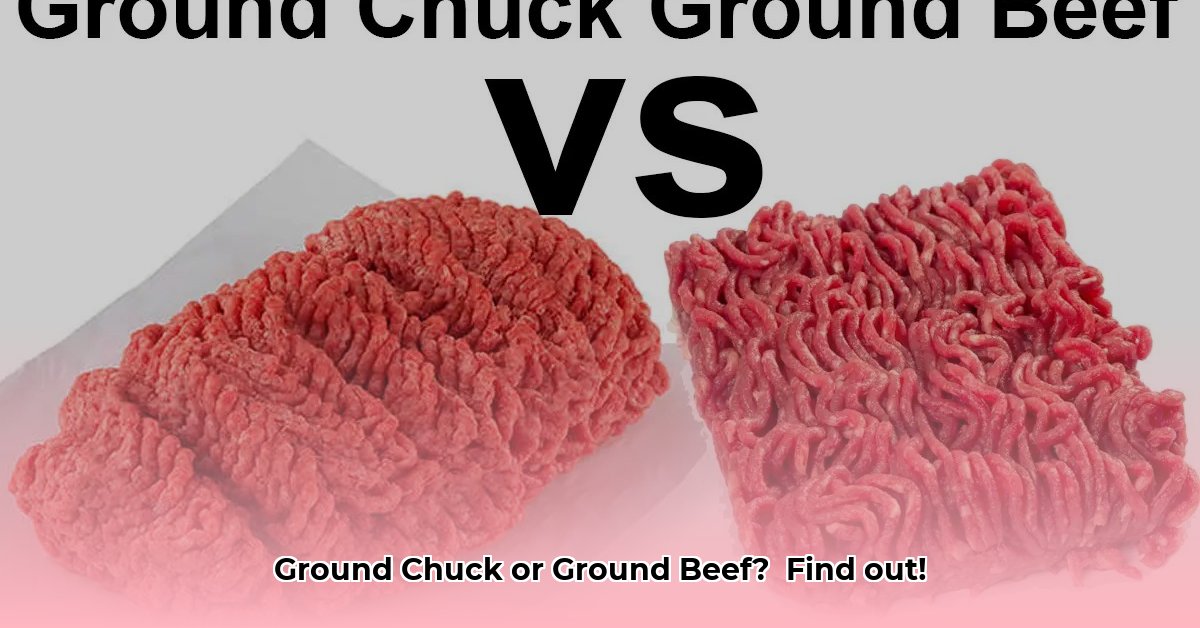Decoding the Grind: Chuck vs. Beef
Let’s get one thing straight: ground chuck is ground beef, but not all ground beef is ground chuck. Think of it like squares and rectangles—all squares are rectangles, but not all rectangles are squares. This seemingly small distinction has big implications for your cooking. We’ll break down the key differences, from fat content to flavor, and guide you toward the perfect grind for every dish.
What is Ground Chuck?
Ground chuck comes from the chuck primal cut, the cow’s shoulder area. This heavily exercised muscle yields richly flavored, well-marbled meat. Grinding tenderizes the naturally tough chuck, making it perfect for weeknight meals. The fat content, typically between 15-20% (often an 80/20 lean-to-fat ratio), is the secret to its juicy, melt-in-your-mouth texture.
What is Ground Beef?
Ground beef is a broader term, encompassing trimmings from various parts of the cow—brisket, shank, round, and potentially even chuck. This blend results in a wider range of fat content, from extra-lean (as low as 5%) to higher percentages. This variability makes ground beef incredibly versatile but also requires closer attention to the label.
Head-to-Head: Chuck vs. Beef
| Feature | Ground Chuck | Ground Beef |
|---|---|---|
| Source | Chuck primal cut (shoulder) | Blend of various cuts |
| Fat Content | Typically 15-20% (e.g., 80/20) | Varies widely (5% – 30%+) |
| Flavor | Rich, beefy | Milder, more neutral |
| Texture | Cohesive, holds shape well | Crumbly (lean), cohesive (higher fat) |
| Price | Moderately higher | Varies, generally lower |
| Best Uses | Burgers, meatballs, meatloaf | Tacos, chili, Bolognese, meatloaf |
Fat: The Flavor and Texture Maestro
Fat is arguably the most important differentiator. It’s the key to ground chuck’s robust flavor and juicy texture, creating that irresistible melt-in-your-mouth burger experience. Leaner ground beef, while a healthier option, can dry out quickly if overcooked. Emerging research suggests that the type of fat, not just the amount, might also influence flavor, with grass-fed beef potentially offering a different fat profile than conventionally raised beef.
Texture: Crumbles vs. Cohesion
Higher fat in ground chuck acts as a binder, holding patties and meatballs together beautifully. Lean ground beef, especially below 15% fat, crumbles readily—ideal for tacos or chili but less suitable for grilling. However, some chefs believe a blend of lean and fatty ground beef gives the best texture for dishes like meatloaf, balancing moisture with structural integrity.
Price: Balancing Budget and Flavor
Ground chuck usually costs a bit more than lean ground beef, reflecting its desirable fat content and concentrated flavor. However, higher-fat ground beef can sometimes be pricier than leaner options due to demand. Price ultimately depends on fat content, source, and market conditions.
Beyond the Basics: Grind Size and Sustainability
Grind size further nuances the texture. A coarser grind lends a “meatier” bite to burgers, while a finer grind creates a smoother, denser texture for dishes like meatloaf. Sustainability is another increasing concern. Grass-fed and locally sourced beef offer potentially different flavor profiles and align with ethical and environmental considerations. Ongoing research explores the impact of different farming practices on both beef quality and sustainability.
Choosing Wisely: The Right Grind for the Job
The “best” grind depends entirely on your culinary goals. Craving a juicy, flavorful burger? Ground chuck is your champion. Whipping up a weeknight chili or taco filling? Leaner ground beef shines. Understanding these nuances empowers you to make informed choices at the butcher counter, elevating your cooking from ordinary to extraordinary. While current knowledge provides a strong foundation, the world of ground beef continues to evolve. Ongoing research constantly refines our understanding of flavor, texture, and the role of fat in cooking, promising even more delicious discoveries in the future.
- How to Stop Apps From Running in the Background to Boost Your - December 1, 2025
- How To Move Apps On Your Droid For Better Organization - November 30, 2025
- How to Move Apps on Android for Better Organization - November 29, 2025










